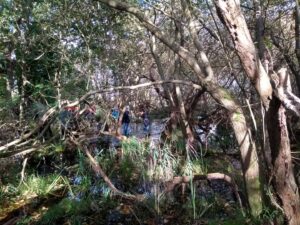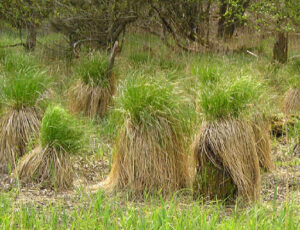Broads Uncovered: Wet Woodlands

Trees don’t usually spring to mind when we think of the Broads National Park, it’s more often wide open skies, rivers, broads, sailing boats, reeds and flat grazing marsh stretching as far as the eye can see. However, the area’s abundant broads, rivers and marshes means there is plenty of water to create the ideal conditions for wet woodland to form. They are the rarest of the wooded habitats in the U.K. – estimates range from 20 – 70 000 hectares only. Within the Broads National Park there are 3,000 hectares of Alder dominated wet woodland and for those of you that have never been for a walk through one they are unforgettable; leaving an indelible impression on your imagination.

Succession: Since the medieval peat diggings, through an ecological process known as succession, nature has been working to turn the open water of the broads into dry Oak woodland (Britain’s climax plant community). Wet Woodland is one of the plant communities (stages) that evolve as open water transitions to dry land (see Figure 1 below). Going for a walk along the boardwalk at Ranworth Broad is a fantastic way to see, in one place, all the various stages of this succession.

There are four main types of wet woodland (carr) found in the Broads National Park: Swamp Carr, Semi Swamp Carr, Mixed Carr and Fen Carr all of which occur on soils that are seasonally or permanently damp or wet. Exactly which type of carr grows in an area is determined by the type of soil, how wet that soil is and for how long each year. These factors directly affect what plants have, can and will grow at a site and therefore, the specific features of the wet woodland in that area. For example, Alder trees can grow to a height of 30m but in Swamp Carr they rarely reach this size – stunted by heavily waterlogged soils and the floating mat of vegetation on which they grow being unable to support their weight. But in Fen Carr where the ground is less wet and actually solid, they will grow to their full height.

How wet the soil is also affects our ability to walk through wet woodland. In Swamp Carr you can’t! Swamp Carr blocks your way with a tangled mass of low growing trees covered in mosses and lichen, thickets of wild currants and guelder rose and beneath your feet a variety of sedges and ferns border eerie pools of mirror still black water ……. And don’t assume just because trees are growing there that the ground is solid. In places like Barton Broad the woodland closest to the broad is actually floating! All the trees and plants are growing on top of a mat of rhizomes (a type of root produced by plants such as lesser reedmace and bulrushes) and leaf litter which in turn is floating on a 10m layer of liquid mud. Even the trees have trouble staying upright. They are often tilted over at bizarre angles or have fallen down entirely as the supporting mat gives way and they sink into the mud below.
Luckily, there are three sites, Ranworth Broad, Upton Marshes and Barton Broad, where board walks have been built at great effort and expense so that we can experience, however briefly, the magic of these tangled, swamp habitats.

Adaptations to living in a Waterlogged World
Not all plants and trees can survive in wet soils – we’ve all killed a pot plant by overwatering it! The various types of Carr in the Broads National Park are dominated by alder trees, a range of willow species and birch trees all of which can grow in damp to wet soils because they have evolved some pretty neat adaptations to cope with the conditions.
The main difficulty of living in wetlands as a plant is the lack of oxygen available in wet or waterlogged soil. Additional difficulties are the potentially low nutrient levels of that soil and the toxins that form in anaerobic (lacking oxygen) environments.

The most widespread adaptation of wetland plants to overcome a lack of soil oxygen is the development of a shallow root system. Tusscock Sedge, an iconic feature of swamp carr which can grow to a metre in height, has both deep roots and a shallow roots which it relies on when water levels rise and flood the lower roots.
Some trees like Alder trees have special cork like cells on the lower part of their trunks that, when the roots are flooded and unable to take up oxygen from the soil, allow air to enter. This air is then transported by a system of air ducts to the very tips of their submerged roots.

Willows, if their roots are submerged for more than a few days, start to grow adventitious roots at or just below the water surface directly from their submerged trunk and branches where oxygen is more readily available. They will use these roots until the soil dries out enough for their other roots to start functioning again. Like the alder trees willows have special openings higher up their trunk called lenticels that allow air to enter the plant and oxygen to be shuttled to their submerged roots.
To deal with the problem of limited nutrients being available in these environments willow trees have formed associations with fungi that make nitrogen and phosphorous available to the tree. Alder trees, rather like the legumes, have nodules of bacteria on their roots which convert atmospheric nitrogen (unusable by plants) to a form that plants can use. This is released into the soil benefiting the tree as well as its neighbours.
A further adaptation of both willows and alders for living in wet areas is the ability to release oxygen from their roots into the surrounding soil. This has two benefits: it detoxifies the immediate environment around the roots as the oxygen oxidises the harmful forms of iron and hydrogen sulphide found in anaerobic soils and helps the roots absorb any available nutrients.

Animals: Although not the most species rich habitat in the Broads National Park (that’s the open fen) wet Swamp Carr, Semi Swamp Carr and Mixed Carr is vital for 59 species of conservation concern, and for Fen Carr, 62 species. It is home to birds that cannot nest, feed and roost in reedbeds and grazing marshes such as woodpeckers, owls, herons, redpolls, siskins and marsh tits. The abundance of water attracts every amphibian for miles around followed of course by grass snakes! Otters make dens (holts) amongst the alder roots and pipistrelle bats flit through the branches hunting the plethora of insect life this habitat supports. Invertebrates abound both in and out of the water from fully aquatic species such as leeches and snails to those that have an aquatic larval stage and terrestrial adult stage like caddis flies and crane flies. Willow trees support more moth species than any other British tree except the Oak and the flitting of moths like ghosts through the branches at night just adds to wet woodland’s enchanted feel. Sampling and identifying all the invertebrate species living in wet woodlands is extremely difficult given the impenetrable nature of the habitat and is still an area to be fully explored.
Hopefully, your appetite has been wetted and you’ll be heading out to discover these hidden gems for yourselves. Remember to sit quietly for a while when you’re there – listen to the birds, perhaps you’ll see a Chinese water deer picking it’s way between the pools or a spider scaling up and through the troll-haired tussock sedges or even a snake….. But don’t forget what’s making it possible for them and you to be there are all those amazing trees above your head!
Useful Links
- Brilliant downloadable and printable tree id guides for children. There’s one’s for leaves, twigs, buds, flowers, The Woodland Trust has it all.
- Not forgetting our urban friends out there here’s the Natural History Museum’s Urban Tree ID guide for you to download and get using.
- Great online games to be played while learning all about trees at Tree Tools for Schools.
- For an interactive introduction to all aspects of trees and plants from their basic parts to how they photosynthesise to medicinal uses to the meat eaters of the plant kingdom and Quizzes for fun click here.
- The Woodland Trust is your one stop shop for all things trees, some fantastic school resources here.
- Teaching resources from the BBC centred around trees can be found here.
- STEM resources for KS1 and KS2 activities built around measuring and identification skills here.
- If you want to know more how succession works then this Youtube link is for you.
- A video guide to some of our common UK trees and their bush craft uses – which tree makes the best fire wood, whistle and which has leaves that taste like lettuce here.
- Another A to Z Bushcraft production this time on some of the medicinal uses of our trees. Watch here.
- Lots of downloadable forestry activity sheets over at Forestry England.
